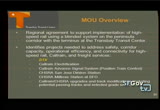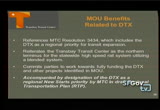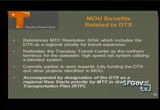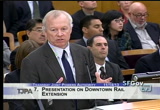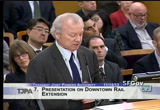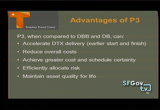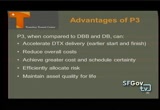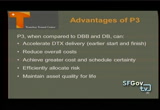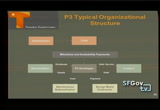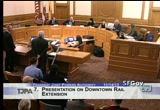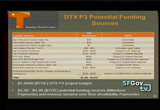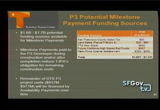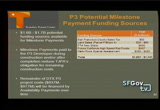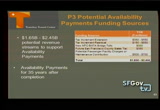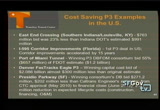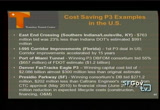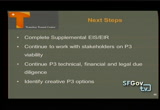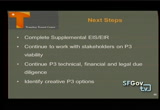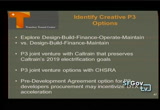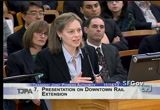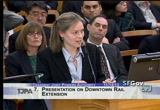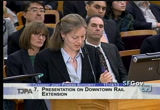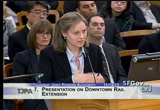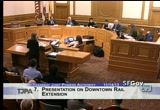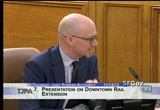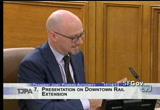tv [untitled] November 17, 2013 5:00am-5:31am PST
5:00 am
same tracks along the cal train corridor and so we needed to come together and take a look at and negotiate, what infrastructure up grades would be needed along the cal train corridor in order to make it ready to accommodate both the cal train and the high speed rail and you see that list on this slide and most importantly from our perspective that included the dtx as well as cal train, electrickfiation and positive train control. and here is a list of the entities that were a party to the mlu or the major regional transportation entities including the djpa as well as mtc and the rail authority and the city and the cta and the cal train, and sam transand dta and the city of san jose. at the same time that the business plan was revised the high speed rail authority had agreed to release the early prop one a funds to the
5:01 am
northern and southern book ends and the idea was that the early funds would be used to deliver, high speed rail, related up grades that could be completed and delivered to the public earlier, than the over all high speed rail system and so also, as part of this mlu it was negotiated that the funds that go to the northern book end would go to complete the cal train electric identification and positive train control because those are important regional projects and certainly relate to the transbay program as well in terms of the dtx and the benefits that were included in the mlu. and included in the reference to mtc resolution, 3434, which included the dtx in the transit expansion and it reiterated that it will be the northern terminus and all of the partis that signed on to work joinly. and to get all of the needed up
5:02 am
grades from it. and in terms of the transbay program as part of this the negotiation it was agreed that the dtx would be designated as a regional priority for the federal program. and the, region has typically carried to the projects, and this is in the new starts with the funding and northern california has received. >> and for the many years, the projects in that type line and the central subway and the first half is the part of the san jose and those two projects were negotiated on the verge of completing the full funding grant agreements which is the last step in the new starts pipeline when you get a full funding grant agreement you get a guaranteed amount for the federal funding for construction and it is a significant amount of funding and so, that opened up the two
5:03 am
shots in the pipeline, and it was a long term goal for tjpa to get one of these designated. and it is falling away and the largest funding stream that exists for this type of a transit expansion, those are made officially made in the regional plan and the most recent version was named, plan bay area and in the plan bay area, the dtx was designated for the regional priority as well as the second half of the project and as part of the plan of the area, and investment strategy and mtc led a negotiation to put together a regional funding plan for the dtx and we wanted to show this to you and provide this quick refresher because you are going to see the numbers in the potential revenue sources that
5:04 am
could be in the npthree approach and so with that i am going to turn it over to jim, who is with spary consulting and is he part of our financial consulting team. >> good morning directors, i am jim martin at sparry capital. and we are an advisory firm and the overview. and now, i don't think of p3 as the appropriate vehicle for every project. i advise, cal transseveral years ago on a 100 million straight resurfacing of i-80. and that was not the profile for a p3 project. a p3 project rather should be complicated, and in large, with challenges that can be
5:05 am
identified and through ensentive and proven to the private sector and we think that it is a prime candidate for several sxraens number one, you have opening in 2017. and number two your environmental work for the extension is almost done and it should be done some time late in 2014 or early 2015. and number three, the 30 percent design work already done. and otherwise, this project is almost shovel ready, which is very important for the infrastructure development and project delivery and on top of that, i want to emphasize the strong support that they have seen here and discuss with the stake holders in the last month but evan agrees that there is a benefit in accelerating the project. and i want to say that again, this is the profile it is a tunnel and the water table issues and this is complex, that lends itself to design the
5:06 am
efficiency and incorporated in p3 and terms of a design build contract with the p3 developer as well as the main nens and facilities. and let me go to the actual advantages of a p3, and now, brian mentioned the acceleration, in terms of the project delivery of a p3:singer project in the recent analysis and it was a slide on slide 29 and through the work with par sons and the urs, that the calculation was that if the p3 could excel by 2 years and that is a significant cost savings and why would ne do that in two years and why could they achieve the 400 million savings over the traditional design to build and now brian mentioned this, the incentive to the developer to finish the construction on time as quickly as possible. and i should mention that i was
5:07 am
the advisor on the parkway and the very successful project, and there, it does not get one dollar with the complete construction that is a 4-year construction period and so clearly, the p3 developer and the short term lenders are anxious for an on time or early delivery of the project and early delivery of the project also saves the p3 developer money and increases the potential. and i would also say that again, we are looking at a p3 with a design contract component to achieve greater certainty in terms of cost control and delivery schedule and i will mention that i worked on a p3 project for a toll road in northern virginia, 1.9 billion, and it opened this year, not one single change
5:08 am
order in that contract. very important in terms of cost certainty and delivery. we mentioned risk allocation. and brian mentioned the fact that hazardous materials and now that was actually a factor in procidio for the military base and that was a list that the cal trans, typically accepts, but the list here for the project sponsor, with the high water table and so one of the risk allocations could be if there is a leakage in the tunnel it would not be available for the train use with the performance based p3 process and they would not get the full compensation and that kind of an oversight or problem in the tunnel. the last thing is that in terms of the advantages is asset maintenance. somebody designed the bill projects and cal transadmits a good example of this and we
5:09 am
wanted to budget problems and defer the maintenance and it can be expensive in the long run or all types of projects. and to illustrate what a p3 project looks like, we will show you the outline and what happens, at its core is that a p3 developer, could be as many as 30 firms in a joint venture group. but the p3 developer forms a limited liability corporation ration. and the people often ask me if, a private entity will have a higher interest rate charge, and a higher cost of capitol than a public agency. and i will tell you that the procedio parkway with the short term bank construction loan with the loans, short term and long term as well as the equity by the developers and the
5:10 am
weighted average cost of the capitol, and less than 2.5 percent. and obviously they are very competitive with the tax exempt financing. now clearly there is a repayment obligation on the part of the project sponsor and that is the upper right-hand side to repay, i am sorry, below that to repay the stake holders to pja to flow all of the funds to pay for the payment of the p3 developer and to whoever receives the fund and allocates those funds and to the design bill contractor and as well as the main nens provider and the design contractor and the many subcontractors to it and the maintenance can be a big job and it can begin for the life of the assets and any questions about the flowchart? >> yeah, i have a question about the flowchart. >> your p3 developers and your shareholders and maybe the
5:11 am
dividends are backwards, but what is seems to me is that what the p3 developer gets out of this, is essentially what the pjpa has in the milestone and the availability payments. >> yes, sir. >> so what you are telling us, then, is that we can save so much money by going p3 that we can afford to put in a whole other layer of management and a whole other layer of stuff, and give the same amount of money to them, and still have money left over? and they will be willing to make a profit and pay those dividends. >> yes, but i could give you clear examples of that later on the presentation. >> i think that it would be good to move on to the funding
5:12 am
sources. >> this is an important slide, and we understand that there are a multiple source of funding sources. >> i have a question and, i am glad that you added in the column and i am curious as to how these numbers were formulate and so for some of the land sales i understand that this is estimation of what we estimate that we will send
5:13 am
or solve the parcels f, and 44, but for these other numbers, how do we estimate. 350 million from the san francisco sales tax. >> i can address that. thank you. >> the 350 is from the regional transportation plan, when we received it to be the priority for the new starts and the investment strategy for the company bay area, and the funding plan for ptx was included and included 350 million, from a sales tax, extension, or other local sources. >> each of these needs have to have a conversation but i think that the key of the local sources that makes me comfortable and as you all
5:14 am
know, the mayor has completed a draft expenditure plan for the sales tax that does not have this number in it but the other local funding sources tbd, sure that makes sense. >> and that is correct, it could be other local or extended and that does not have to be new sales tax it could be extended sales tax as well, i believe, right, scott? so it does not have to be the new one. >> we have modeled out the extension, and what are the assessment and we have calibrated and to put on ranges here and because we are quite sure because we are looking at future values and revenue streams. but the plans will be, and that is the range, and the range of
5:15 am
assumptions and in terms of total funding sources. >> okay. >> and the next page. >> a milestone payment, at the end of completion and that is analogous to a down payment and those funding sources were largely a local contributions from the ta and mtc and the golden gate bridge and some cal transfupds.
5:16 am
there could be multiple payments halfway through or all of the final and this is the model and we followed the proceedings and the financial model. and the range for the funds for the short term cash infusions for 1.6 and 1.7 billion dollars, and these are critical to the p3 developer and you heard brian talk about the caring costs and you can imagine the caring cost if you are a p3 developer of raising 1.6 billion for construction and with the incentive and the project delivery, and we took the balance, and look at structuring availability payments and so if you look at the next slide, we have taken the revenue streams over time
5:17 am
and put together analysis for availability payments. and now, again i want to stress, that mild stone payments, and maybe the ability payments are not like a debt service obligation and they are performance based. and they have to earn these to get the aid and now, on the long term, availability payments in a p3 agreement, there is a very, long, technical discussion, about what qualifies as a deduction from the availability payment. and the deduction could be that it is not available. and it could be that there is a lighting problem and this is thought out and detailed with the engineers and the technical staff and a precise methodology and as for the aspect in the transaction. and now, i mentioned earlier on some hard examples of transactions which have been very successful and these are
5:18 am
all p3 bids from around the country. and the very first one, indiana, and kentucky and a bridge, a bridge is a great concept and a great project in terms of a profile for p3 and in terms of the construction and now the indiana dot did the engineer's investments and the actual bid for the component and for the bid contract was 33 percent less than engineers estimate. and now this was a bid last year. so not during, and the actual recession, when the contractors were actually very aggressively bidding, and designed to build the contracts and the p3s as well and i mentioned again, the two projects in florida, and the 595 toll road, and the port of miami tunnel, and these are both availability payment transaction and again, once again, florida, dot made projections and the engineer's
5:19 am
estimates and the p3 bids and the design build components were dramatically less than the engineer's estimates. and the denver fast track and the project and a similar in some ways. and similar to dtx and it is a transit project. and it is based upon the design building of additional tracks and stations and any rail and maintenance yard and this was the procurement of the vehicles in the ongoing operations and main nens for those vehicles. and so imagine, baters trains being subject to performance based payments in terms of cleanliness and appearance in terms of p3, operating agreements. and is there a last one that was prosidio parkway and the winning developer the bid was 271 million dollars when the actual cal transestimate was close to 470 million dollars.
5:20 am
and again, the petri developer assumes the responsibility to go out and solicit the funds and debt as well as equity and the completing before they were paid anything at all. >> now that is a brief overview of a p3 transaction and the lies and the complex analysis. lets go to the next steps of your decisions here and again, i mentioned that this is a near shovel ready project and we will continue to work with your stake holders on the p3 and i want to emphasize that the work with the cal train and they were very engaged in looking at potential joint ventures and i want to offer that mtc and was supportive and the p3 was a
5:21 am
very attractive way to accelerate the delivery and the lower costs of dpx and also mention that after our meeting with mtc and the ta and actually called me and suggested that they can actually work side by side with tjpa to facilitate the analysis of a p3 option and in terms of coming back to you in the future after our additional due diligence, and again, legal, technical financial, come back to you, after with a very sophisticated business case presentation. with the very accurate and detailed qualitative and quantitative assessments. of a p3 option verses a design to build or design build. and again, i want to emphasize in terms of the financial due diligence, our job in working with you and the staff is to look for a more creative p3
5:22 am
options and i should say that there was no single p3 model and each p3 that i have seen is unique, and a ctc commissioner said in two years ago in the presentations that if you have seen one p3, you have seen one p3, and so we were taking all of the input from the stake holders and working with the technical team and we are working with the lawyers and looking at the best unique set approaches and the particular project and we have a few suggestions here and we talked about, expanding the p3 scope, from the design that it finance maintained and to the design build and operate and maintain and that is an option. >> is this okay? i think that we are at the last slide. >> we are. >> and i imagine that we are at the hour point for the presentation now, i was hoping to move on to, i know that we have other folks here that wanted to speak on this item
5:23 am
and move on to a board discussion if that is okay. >> and also, questions. thank you for your time. >> thank you very much. >> and i have received the san francisco county transportation authority here as well and our deputy director, and so i know that she also, is here to present or say a few words as well. >> and you have to address you after. >> after the board discussion. >> thank you. >> good morning, directors and the chief deputy of the transportation authority and i will be very brief, i am sure that you have an interesting discussion here. >> and we are very pleased to see the transbay joint power authority looking at alternative delivery methods that is critically important. and i understand and the method for the right project and it is for it is fought with its own opportunities and in the cal train just made the decision to do and give a different method
5:24 am
to design, build for the electrickfiation and once you make that decision the work has started and this is a serious decision that is worth explaining and it needs to be explored looking at your cost and funding plan and because as you secure it the designs of the methods have the methods on the total cost and cash flow and it is one of the things where the p3 approach is very attractive. and for the benefit of those watching and the board and although you you are more on this and i just want to make it clear that the public, partnership is not a... and it is just like any other delivery firm and they are there to make a profit and i know that one of the steps and i know that brian has started and you need to have a bullet proof business case and i want to be debbie downer but the numbers are very rosy in terms of when the production might start and also
5:25 am
a lot to do with escalation costs and the project decides each year and each month because it is big dollars and so we are looking for toward to continuing to work with tjpa and we are delighted no matter what option is chosen and this is one of the signature projects in the prop k and we do want to clarify the question about the prop k, project and so it is the 350 million, and it was assumed in the regional transportation plan and the milestones of this project achieved in that was getting designated for one of the new start is significant as is the regional high speed rail and it is not the same as having the money in the bank, it is not a business deal. and so you can actually move for toward and with that, i am very delighted, also to volunteer as much time as you need from this, and from the capitol projects to share all of those battle scars and how
5:26 am
far it was, and very solid, two years, and two years of... from the former executive director just to make the p3 happen. >> actually i did have a question, part of the advantage of going down the route for this project is assuming that you know the environmental reviews completed next year, and this is a shovel-ready project to go. and i was just kind of curious from the ta's perspective about the shovel readiness of the project and kind of what other steps need to be taken to get to that point. and there is no single p3 model
5:27 am
because it depends on at what point you want to hand off the design, when i look at the funding streams that are relatively good working plan and that is the small percentage of the funding that has been secured and most for the sources on here like the new and the reauthorization and the sales tax increase and the high speed rail signs and we have to wait until even from the year to the election years and so my reception is that it is probably going to be a two or three years until all of the money is lined up and so it may be that if there is a need to look at lower costs which is probably the case with the big project and that triggers the need to reopen the environmental we have time to deal with that and on the foregone conclusion. >> thank you. >> director metcalf? >> i want to first of all say that i am so thrilled that we are talking about the dtx, this, yeah, you can sit down and i might have a question for you. but i am really pleased that we
5:28 am
are talking about this phase, and i hope that kind of for this and this can be a major focus of our time for the board and thank you for such a thorough overview and presentation and i feel like it lays out a bunch of things that we are going to need to delve into and talk about, from what you presented the design build, finance, maintain option looks really appealing and the it really has turned out well, and i think that one of the san francisco examples that has gotten this city familiar and comfortable. with it. i think that it would be really great if as you just said, if the ta and the tjpa can joinly design this and the ta is the agency here that has the experience without having done one of these, and those are the big lawsuit that the ta dealt
5:29 am
with from the cal transengineers and i expect that we will face similar issues if we go down this road and i want to understand, that. that the practice, and i think that any way exploring the intracaseys of the p3 option is something that i want to do. in terms of the design. and itself. and it is a really good presentation, on that. and i would love to have the planning department come and present, i know that they are doing a study of their own thinking about alignment issues and options, and ultimately, we need to have, the city and cal train high speed rail, and the ta, and all agreeing about the path forward and the only way that we are going to be really be sure that we are there if we
5:30 am
are bringing those agencies so that we can hear from all of them. i really, it is so good, to have you here. i mean that i really want to make sure that we work out the issues like in this blended system are we have compatible stock and the high speed rail and cal train going to be the same platforms or not? none of this works, unless we get those details worked out. and so any way, and i am hoping that we can go into more depth. >> any other comments, director reiskin? >> i would concur with what he said and it is great to bring this forward now, and i think that with the phase one, we should shift the focus of this board to phase two, and when we reemphasize what scott noted
34 Views
IN COLLECTIONS
SFGTV: San Francisco Government Television Television Archive
Television Archive  Television Archive News Search Service
Television Archive News Search Service 
Uploaded by TV Archive on

 Live Music Archive
Live Music Archive Librivox Free Audio
Librivox Free Audio Metropolitan Museum
Metropolitan Museum Cleveland Museum of Art
Cleveland Museum of Art Internet Arcade
Internet Arcade Console Living Room
Console Living Room Books to Borrow
Books to Borrow Open Library
Open Library TV News
TV News Understanding 9/11
Understanding 9/11